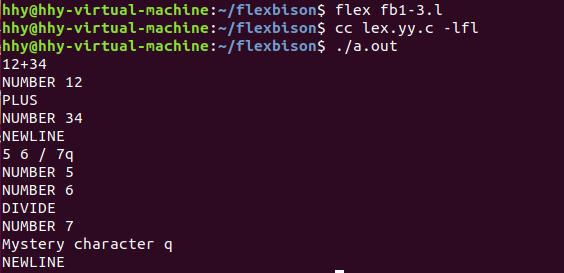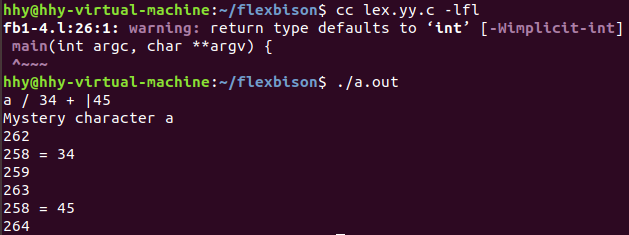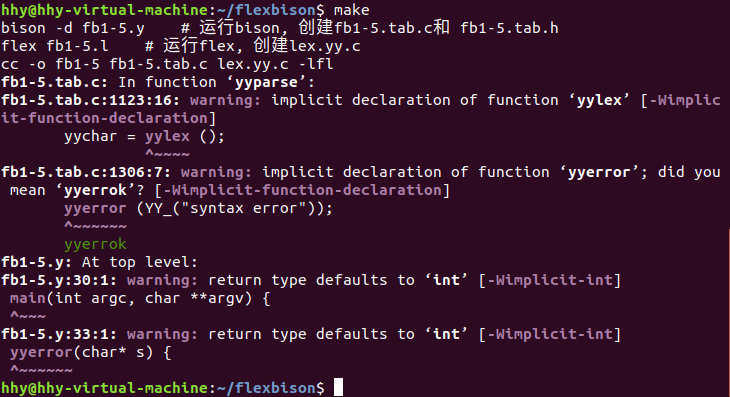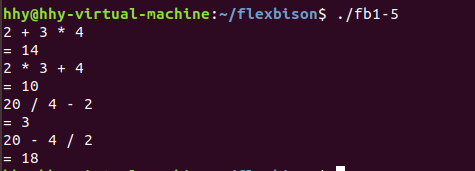Flex&Bison 简单入门
- Ref: 《flex与bison(中文版)》
1. Flex&Bison安装
- 安装flex
sudo apt install flex
- 安装bison
sudo apt install bison
- 安装gcc(若缺少)
sudo apt-get install -y build-essential
2. Flex&Bison使用
2.1 第一个flex程序
- Flex程序 例1-1: 字数统计 fb1-1.l
/* 正如Unix的wc程序 */
%{
int chars = 0;
int words = 0;
int lines = 0;
%}
%%
[a-zA-Z]+ { words++; chars += strlen(yytext); }
n { chars++; lines++; }
. { chars++; }
%%
main(int argc, char **argv) {
yylex();
printf("%8d%8d%8dn", lines, words, chars);
}
- 运行程序:
$ flex fb1-1.l # 使用flex翻译程序
$ cc lex.yy.c -lfl # 编译程序, 与flex库文件链接
$ ./a.out
The boy stood on the burining deck
shelling peanuts by the peck
^D
2 12 63
- 注:
^D是Unix/Linux文件结束符, 此处用于结束输入
- 运行截图

2.2 Flex&Bison协同工作
1. Flex程序1
例1-3: 一个简单的flex词法分析器 fb1-3.l
- 代码:
/* 识别出用于计数器的记号并把它们输出 */
%%
"+" { printf("PLUSn"); }
"-" { printf("MINUSn"); }
"*" { printf("TIMESn"); }
"/" { printf("DIVIDEn"); }
"|" { printf("ABSn"); }
[0-9]+ { printf("NUMBER %sn", yytext); }
n { printf("NEWLINEn"); }
[ t] { }
. { printf("Mystery character %sn", yytext); }
%%
- 运行程序:

2. Flex程序2
例1-4: 计算器词法分析器 fb1-4.l
- 代码:
/* 识别出用于计数器的记号并把它们输出 */
%{
enum yytokentype {
NUMBER = 258,
ADD = 259,
SUB = 260,
MUL = 261,
DIV = 262,
ABS = 263,
EOL = 264
};
int yylval;
%}
%%
"+" { return ADD; }
"-" { return SUB; }
"*" { return MUL; }
"/" { return DIV; }
"|" { return ABS; }
[0-9]+ { yylval = atoi(yytext); return NUMBER; }
n { return EOL; }
[ t] { /* 忽略空白字符*/ }
. { printf("Mystery character %cn", *yytext); }
%%
main(int argc, char **argv) {
int tok;
while(tok = yylex()) {
printf("%d", tok);
if(tok == NUMBER) printf(" = %dn", yylval);
else printf("n");
}
}
- 运行程序:

3. 简单的计算器程序
- Bison代码:
例1-5: 简单的计算器 fb1-5.y
/* 计算器的最简版本 */
%{
#include <stdio.h>
%}
%token NUMBER
%token ADD SUB MUL DIV ABS
%token EOL
%%
calclist: /* 空规则 */
| calclist exp EOL { printf("= %dn", $2); }
;
exp: factor { $$ = $1; }
| exp ADD factor { $$ = $1 + $3; }
| exp SUB factor { $$ = $1 - $3; }
;
factor: term { $$ = $1; }
| factor MUL term { $$ = $1 * $3; }
| factor DIV term { $$ = $1 / $3; }
;
term: NUMBER { $$ = $1; }
| ABS term { $$ = $2 >= 0? $2 : -$2; }
;
%%
main(int argc, char **argv) {
yyparse();
}
yyerror(char* s) {
fprintf(stderr, "error: %sn", s);
}
- 注: 书上代码有误, 上已修正
- Flex代码:
例1-6: 计算器词法分析器 fb1-5.l
%{
#include "fb1-5.tab.h"
%}
%%
"+" { return ADD; }
"-" { return SUB; }
"*" { return MUL; }
"/" { return DIV; }
"|" { return ABS; }
[0-9]+ { yylval = atoi(yytext); return NUMBER; }
n { return EOL; }
[ t] { /* 忽略空白字符*/ }
. { printf("Mystery character %cn", *yytext); }
- 编译的Makefile:
fb1-5: fb1-5.l fb1-5.y
bison -d fb1-5.y # 运行bison, 创建fb1-5.tab.c和 fb1-5.tab.h
flex fb1-5.l # 运行flex, 创建lex.yy.c
cc -o $@ fb1-5.tab.c lex.yy.c -lfl
- 进行编译
$ make
- 遇到问题: Makefile:2: *** 遗漏分隔符 (null)。 停止。
解决: Makefile文件中, 缩进是TAB分隔符, 不能是空格 - 遇到问题:


解决: 见上#1代码
编译信息:

- 运行结果:

最后
以上就是舒服铃铛最近收集整理的关于Flex&Bison 简单入门Flex&Bison 简单入门的全部内容,更多相关Flex&Bison内容请搜索靠谱客的其他文章。
本图文内容来源于网友提供,作为学习参考使用,或来自网络收集整理,版权属于原作者所有。








发表评论 取消回复